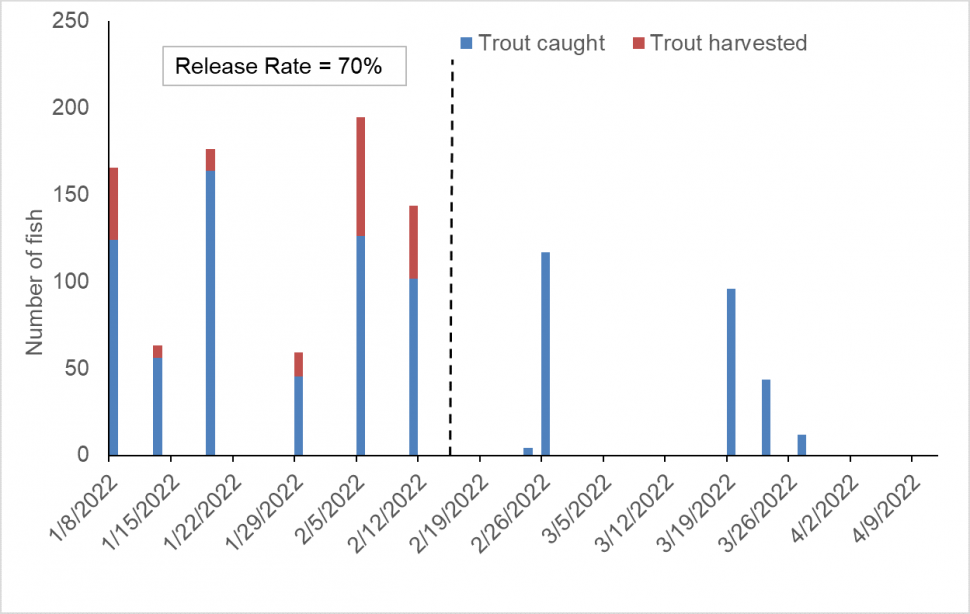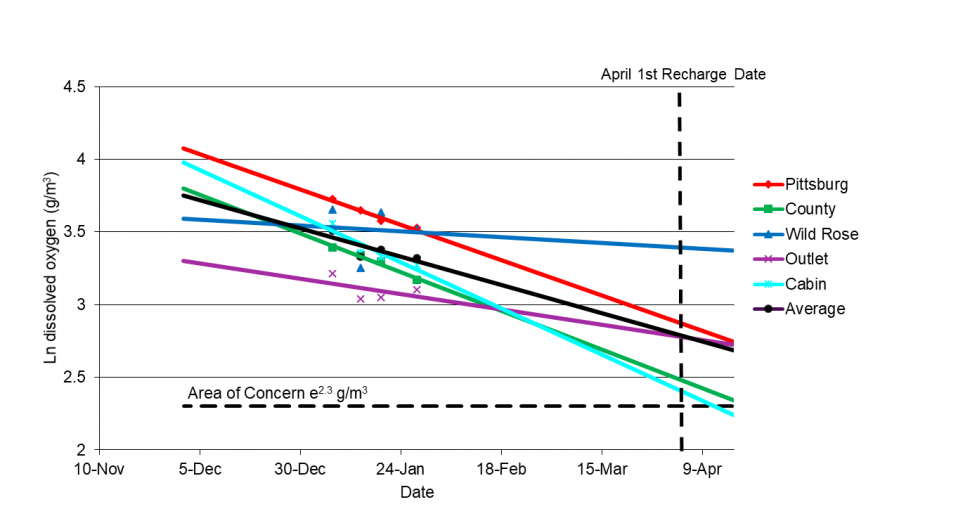New 2022 Henrys Lake Regulations
With the new regulations in full-effect, fishing opportunities at Henrys Lake have been significantly expanded. As a reminder, the current Henrys Lake fishing regulations for 2022 are as follows:
Section: Those portions of the lake within the posted boundaries of Staley Springs and within 100 yards of Hatchery Creek
- Closed to fishing
Remainder of Henrys Lake
- February 15 through Friday before Memorial Day Weekend - trout limit is 0, catch-and release
- Saturday of Memorial Day Weekend through February 14 - trout limit is 2, Brook Trout counted in the trout limit
- Fishing must cease after the 2-trout daily bag limit has been retained
Henrys Lake Year-Long Creel Survey
We’re keeping an extra-close eye on the fishery after the regulation change by conducting a year-long creel survey. Every week, we will be interviewing anglers asking about species-specific catch rates, fish sizes, angler demographic information, and much more. These data will help us better understand how angler effort, angler harvest, and user-group types have changed with the expanded opportunity. It will also provide insight into how angler catch rates relate to the current fish population and species composition.
Here, we can take a look at some of our preliminary findings from the creel survey we’ve completed since the beginning of the year. Angler effort was much higher during the extended harvest season than during the catch-and-release season (Figure 1), despite a release rate of 70% during the extended harvest season (Figure 2). Catch rates were comparable between the extended harvest season and the catch-and-release season (Figure 3), although this may be a function of decreased effort during the catch-and-release season, as anecdotal evidence suggests catch rates have improved since mid-February.
Anglers are certainly taking advantage of the increased opportunity at Henrys Lake during the ice fishery. Although effort declined during the late-ice season, the onset of spring and ice-out fishing will likely attract significant attention from multiple angler types.

Figure 1. Angling effort on Henrys Lake during the extended harvest season (Jan 1 – Feb 14; left of vertical dashed line) and newly-opened catch-and-release season (Feb 15 – Friday of Memorial Day weekend; right of vertical dashed line). Red dots indicate creel events that occurred on weekends and blue dots indicate creel events that occurred on weekdays.

Figure 2. Number of fish captured by anglers during the extended harvest season (Jan 1 – Feb 14; left of vertical dashed line) and newly-opened catch-and-release season (Feb 15 – Friday of Memorial Day weekend; right of vertical dashed line). Red bars indicate the number of harvested trout while blue bars indicate the total number of trout caught.

Figure 3. Angling catch rates in Henrys Lake during the extended harvest season (Jan 1 – Feb 14; left of vertical dashed line) and newly-opened catch-and-release season (Feb 15 – Friday of Memorial Day weekend; right of vertical dashed line).
Henrys Lake Spawn
The 2022 Henrys Lake spawn looked a lot like it did last year! Fortunately, that means that everything went smoothly and we have all the fertilized eggs we’ll need (and more) for this year’s stocking. Unfortunately, that also means that we were still under COVID-19 protocols and were unable to have our passionate volunteers come help us out. We’re very much looking forward to next year when we’ll be able to have more volunteer involvement, so please reach out (Nathan.Tillotson@idfg.idaho.gov) if that sounds like something you’d like to get involved in! There are limited spots available for this, but plenty of other ways to get involved both up at Henrys Lake and in other IDFG activities. For all things Henrys Lake, give me (Nathan Tillotson) a shout at the email above, and for other ways to get your hands dirty, reach out to our Volunteer Service Coordinator (Gerren Steel; Gerren.Steel@idfg.idaho.gov).
For those that may not know, we operate a small hatchery located at Henrys Lake. We have a spawn shed (Figure 4) situated directly on top of a spring-fed tributary and a fish trap/ladder (Figure 5) leading from the spawn shed down to the lake. Each spring, Yellowstone Cutthroat return to the fish ladder to spawn. We facilitate that process and thereby greatly increase the fertilization rate and subsequent survival of the fry. During our spawning operation, we produce both pure Yellowstone Cutthroat Trout as well as sterile hybrid trout (Yellowstone Cutthroat Trout x Rainbow Trout). For the hybrids, we collect eggs from females on-site at Henrys Lake, and mix them with milt collected from Rainbow Trout from the Hayspur Fish Hatchery earlier that morning. To preserve the genetics of our Henrys Lake Yellowstone Cutthroat Trout population, it’s important that these hybrids can’t reproduce, so we sterilize the fertilized eggs using a specialized pressure chamber. We hold the eggs at 9,500 psi for 5 minutes, which disrupts cell division and results in triploid fish that are unable to successfully reproduce.
This year we operated the trap from January 22 – March 4, capturing a total of 6,311 unique fish. We completed the hybrid trout spawn the first week of March using 392 females and producing an estimated 953,989 fertilized eggs. The following week, we completed the Yellowstone Cutthroat Trout spawn using 588 females and producing an estimated 1,440,936 fertilized eggs! We incubate the eggs for nearly a month (28 days) until they reach the “eyed up” stage and are tough enough to travel. From there, we take the hybrid trout eggs to American Falls hatchery to be reared until they are ready to be stocked in June, while the Yellowstone Cutthroat Trout eggs are taken to Mackay Hatchery to be reared until they are ready to be stocked in September.


Figure 4. Outside the Henrys Lake Spawn Shed.

Figure 5. Henrys Lake fish ladder leading from the lake to the spawn shed. If you look closely, you can make out two Yellowstone Cutthroat Trout “climbing” the ladder!
Winter Oxygen Levels
Each winter we monitor dissolved oxygen levels at six sites throughout Henrys Lake. Adequate concentrations of oxygen in the water are crucial for fish survival, and winter fish kills can occur if oxygen levels get too low. As more ice and snow cover the lake during the winter months, light penetration is limited and the abundant vegetation throughout the lake begins to die off. As that vegetation decomposes, oxygen is consumed and carbon dioxide is released by the decomposition process. Because of this and other oxygen-consuming processes that occur under the ice, it is important for us to continually monitor oxygen levels. Fortunately, through just a few sampling events, we can use simple statistics to predict how low the oxygen levels will get throughout the season (Figure 6). In the 2022 ice season, none of the sites were predicted to drop below critical levels before the “recharge” date when oxygen levels begin to rise again (Figure 6).

Figure 6. Winter dissolved oxygen levels in Henrys Lake. Horizontal dashed line indicates low dissolved oxygen levels. Vertical dashed line indicates the April 1st recharge date when dissolved oxygen levels begin to rise.
Upcoming Work (April – July)
- Gillnetting: Our annual gillnet survey takes place just after ice-off. Although typically in April-May, the late ice season we’re having this year may keep up from starting until mid-late May. The information we gather from these annual surveys allow us to monitor trends in abundance, size, age-structure, and survival of trout and Utah Chub in Henrys Lake. This information is particularly important this year for monitoring any potential changes due to the new fishing regulations.
- Henrys Lake Opener: The “opener” this year will be a little different than in years past. Although it will be the harvest season opener, catch-and-release fishing is now allowed year-round! Regardless, IDFG staff will be stationed at Henrys Lake access sites all weekend conducting creel surveys that will help inform us about how fishing pressure during the opener has changed with the new regulations.
- Electric Fences: Each June, through a cooperation with multiple landowners and ranchers we install miles of electric fencing along Duck, Howard, Targhee, and Kelly creeks and along the lake. These fences help to keep livestock out of the riparian areas of Henrys Lake tributaries and off the shoreline of Henrys Lake. By limiting access to these important tributaries by livestock we can protect vital in stream habitat for Yellowstone Cutthroat Trout.
- Fry Sampling: This year, instead of fry traps, we’re going to conduct backpack electrofishing surveys in Henrys Lake tributaries to better inform us about the level of natural reproduction occurring in the lake. We will also collect small tissue samples for DNA analysis that will tell us whether or not the parents of these fry were wild or hatchery fish. All of this information is vital for understanding the level of natural reproduction occurring in Henrys Lake and the proportion of wild vs. hatchery natural reproduction.
Ask a Biologist
I’m sure it’s just because people don’t know how to get ahold of me yet, but my email has been pretty quiet with questions from you all! If there’s anything you are interested in knowing about Henrys Lake fishing, the health of the fishery, or fisheries biology/ecology in general, don’t be afraid to ask! My email is Nathan.Tillotson@idfg.idaho.gov and I’m happy to help educate however I can.
For now, I’ll ask you all to do us a favor instead. We will begin our Henrys Lake gill net survey as soon as ice leaves the lake this year, which is looking like it will happen in the next couple of weeks. While we have been able to conduct these surveys prior to the “opener” in previous years, we expect many boaters to be taking advantage of the new fishing opportunities this year. Please be on the lookout for our orange buoys, give them a wide berth, and do not drive in between them. This will not only help us get better data on the state of the fishery, but also prevent any damage to your boat props/lower units if they were to get wrapped up in our nets. Stay safe out there, have fun, and don’t forget to send along any questions you may have for future “Ask a Biologist” sections of our quarterly newsletter!

